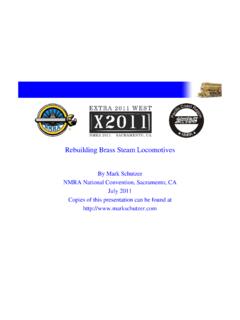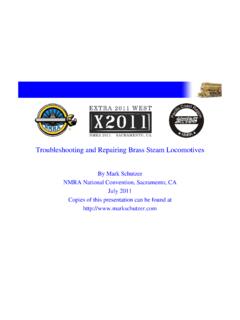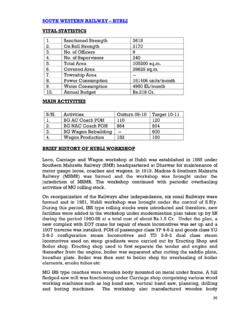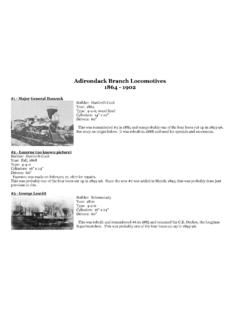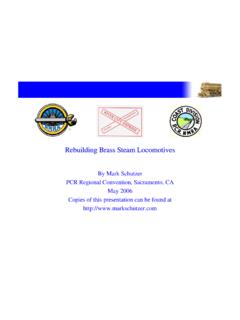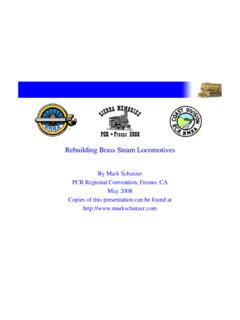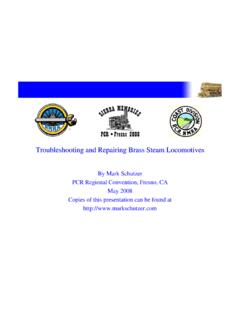Transcription of Honorary President Professor Dugald Cameron OBE - NBLPG
1 Honorary President Professor Dugald Cameron OBE SEASON OPENER (Photo KL Collection) The UK steam season got off to a flying start on Friday 27th January with the Great Central Railway s Winter steam Gala . Six locomotives were running on the Friday and eight each day on the Saturday and Sunday. As with previous events, BR Standard and LMS types predominated over the weekend but for many of us the star of the show was NBL Scotch Arthur No 777 Sir Lamiel (NB 23223) which worked several dining car trains from Loughborough to Leicester North and return. The frosty conditions provided impressive steam effects and No 777 with its BR Carmine & Cream coaches running on the double track main line, created the perfect illusion of a late 1940 s Southern Region express.
2 The immaculate ensemble is seen above approaching the popular viewing location at Kinchley Lane which is situated between Quorn & Woodhouse and Rothley Stations. Completed at Hyde Park Works in June 1925, Sir Lamiel is the only survivor of the thirty King Arthurs that were built by NBL for the then Southern Railway. However, another NBL King Arthur boiler still exists and has run in the preservation era with S15 4-6-0 No 30828. (2) INDIA s DHR (Continued) (Photos David Rodgers / Adrian Shooter) Continuing on from last month s feature, the DHR is now more than 130 years old, having opened from Siliguri to Kurseong in August 1880, the extension to Darjeeling following less than a year later in July 1881. Some of the surviving B Class locomotives are almost as old as the line itself having been introduced by Sharp Stewart in 1889.
3 The design was perpetuated by North British until 1925 and later examples came from Baldwin and the last one, from India s Golden Rock Works was completed as recently as 2007. As can be seen from David s photographs, they usually carry a crew of five people including a driver and fireman, a coal breaker and two sanders who perch precariously on the buffer beam to sand the rails ahead of the train ! The DHR s steep gradients ensure that the sanders are kept pretty busy throughout the journey. By the way, several people have asked about the nickname Weegie B s that is sometimes applied to these diminutive locos no, it s not our own invention ! Reference to my wife s Scottish slang dictionary The Patter shows that the term Weegie indicates someone (or something) originating from Glasgow ! Nowadays you don t actually have to travel to India to sample DHR action as the atmosphere of the railway, complete with DHR B Class No 19 (above left) has been superbly captured at the Beeches Light Railway near Oxford.
4 The Railway will be operating on Sat May 13th, Sun June 11th and Sat Sept 2nd this year and the entry price, including a delicious BBQ lunch, as many rides as you like and visit to engine and carriage shed, has been held at 30 per head. This is a wonderful day out so if you would like to visit this unique railway please contact Ken on 01189 864 706 asap and we will try to co-ordinate another visit. (3) 61662 APPEAL (photos KL Collection) Our weekly work parties have made good progress recently despite some very cold and occasionally rainy weather. More than 100 holes have now been drilled in the smokebox and the wooden former has been cut to size and fitted to the front. Until we have sufficient funds in hand to get the front ring cast the wooden former will enable the smokebox door to be fitted for display and will prevent the weight of the chimney from distorting the smokebox itself when fitted.
5 We have been searching for a B17 chimney for some time now so we can have it copied and avoid the high cost of making a pattern from scratch. This is becoming urgent so if anyone knows the whereabouts of a suitable item please contact us as soon as possible. Funds are needed for both the front ring casting and the chimney so if you can help in any way please visit : (4) MELBOURNE S DIAMONDS (Notes & photos : Derek Rayner) Adjacent to North Williamstown station in the West of Melbourne, Victoria, is the railway museum of the Australian Railway Historical Society. This museum is close to Victorian Railway s Newport Workshops where many steam locos were constructed and the ARHS has amassed a collection of around thirty 5ft 3in gauge locomotives there, steam , diesel and electric, as well as many examples of rolling stock.
6 After being in the open-air for many years, the museum is soon to be transformed with coverings provided over many of the exhibits. Of major interest to potential visitors from the UK are a couple of Glasgow-built steam locomotives, separated in time by some 60 years which are remarkably different in scale and use. The oldest and smaller of the two locos - is an 1890 crane tank manufactured by D bs & Co in Polmadie which, with a tender, was used for lifting heavy components in and around railway depots and works. This compares with a large R Class main-line passenger loco No R704 - the claim to fame of which is that it was displayed in 1951 at Glasgow s Exhibition of Industrial Power held at the Kelvin Hall as part of the Festival of Britain. This show was somewhat unpopular at the time and is often described as Glasgow s Forgotten Exhibition . The 4-6-4 (Hudson-type) loco was built in Glasgow by the North British locomotive Company, of which D bs was one of the constituents in 1903 and therefore both sport the well known diamond-shaped worksplates.
7 Ed - Many thanks to Derek for sending us these interesting notes and photos, his full article can be read in the Vintageworld section of the February 2017 issue of Old Glory magazine. (5) SECR D s & D1 s. (Photos : ) In 1901, Harry Wainwright of the South Eastern & Chatham Railway introduced a new and very stylish Class of 4-4-0 s to haul express on the Kent Coast lines. Despite a relatively light weight of only 50 tons, the D Class were powerful and sure-footed locomotives that responded well to hard work. Twenty of the original locomotives were built in Glasgow, shared equally by Dubs & Co and Sharp Stewart with the balance of 31 being made up by the SECR s Ashford Works, Robert Stephenson and the Vulcan Foundry. These beautiful little engines, with their symmetrical lines and flowing curves, were considered to be some of the most elegant steam locomotives ever to run in the UK.
8 Their intricate lined green livery and brightly polished brass dome covers gave rise to the Class name of Coppertops . 12 years after their introduction, Wainwright was succeeded as SECR CME by Richard Maunsell and from 1921 onwards he rebuilt almost half the Class with more powerful boilers to cope with increasing loads. The rebuilt engines were classified D1 and were very similar in appearance to his L1 Class 4-4-0 s, 15 of which were built by North British in 1926. A total of 28 D s and 20 D1 s survived into British Railways ownership in 1948 and the last three were withdrawn in November 1961. Happily one of the original D s, No 31737 has been preserved in full SECR livery at the National Railway Museum in York. Our photos show three of the Dubs locomotives, No 31075 passing North Camp in October 1956, No (3)1092 in Southern Livery at Ashford in 1937 and rebuilt D1 No 31489 on arrival at Margate in May 1959.
9 (6) FAST & FURIOUS (Photos : & NB Loco Co) During the worldwide quest for more and more powerful steam locomotives in the nineteen twenties, the LMS Railway commissioned NBL to build an experimental high pressure 4-6-0 which carried the running number 6399 and the name Fury . Designed under the auspices of CME Sir Henry Fowler, the locomotive was a joint venture between the LMS and the Manchester based Superheater Company. The latter firm had responsibility for constructing the complex, 3 stage Schmidt type boiler which was pressed to 900lbs psi. After a few short runs in January 1930, a longer test run from Glasgow to Carstairs was scheduled for 10 February 1930. Approaching Carstairs station at slow speed, one of the ultra-high-pressure tubes burst and the escaping steam ejected the coal fire through the fire-hole door, killing Mr Lewis Schofield who was on the footplate representing the Superheater Company.
10 After this tragedy the engine never entered normal service and was transferred to Derby for further testing. A number of design shortcomings were found and it was rebuilt on more conventional lines in 1935 to become the final member of the Royal Scot Class. Our photos show the locomotive (NB 23890) outside Hyde Park Works when new in 1929, on a test run near Long Eaton in 1933 and at Euston in 1959 after rebuilding as Royal Scot No 46170 British Legion . (7) NEWS IN BRIEF (Photographer Allen Jorgensen collection Dick Manton) We are greatly indebted to Dick Manton for very kindly sending this superb photo of our Dubs Tank No 196 whilst it was working at Daggafontein Mines in the 1970 s. After this, the engine transferred to Springfield Colliery from whom we acquired it when it was taken out of service in the 1980 s.
